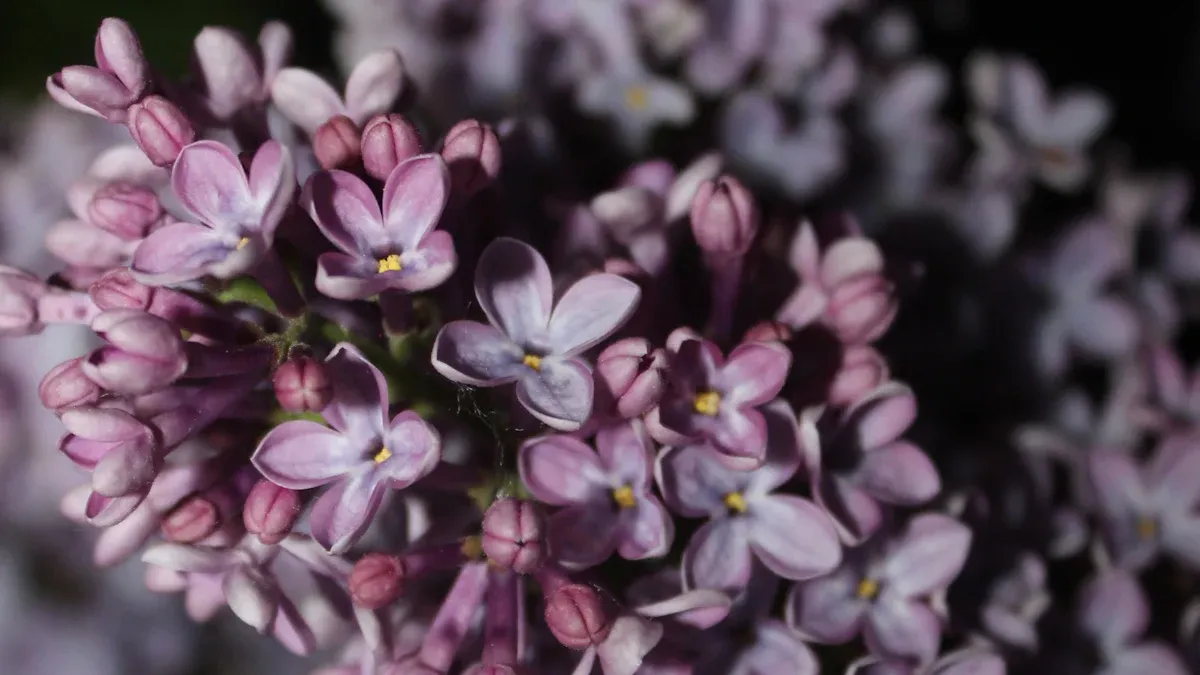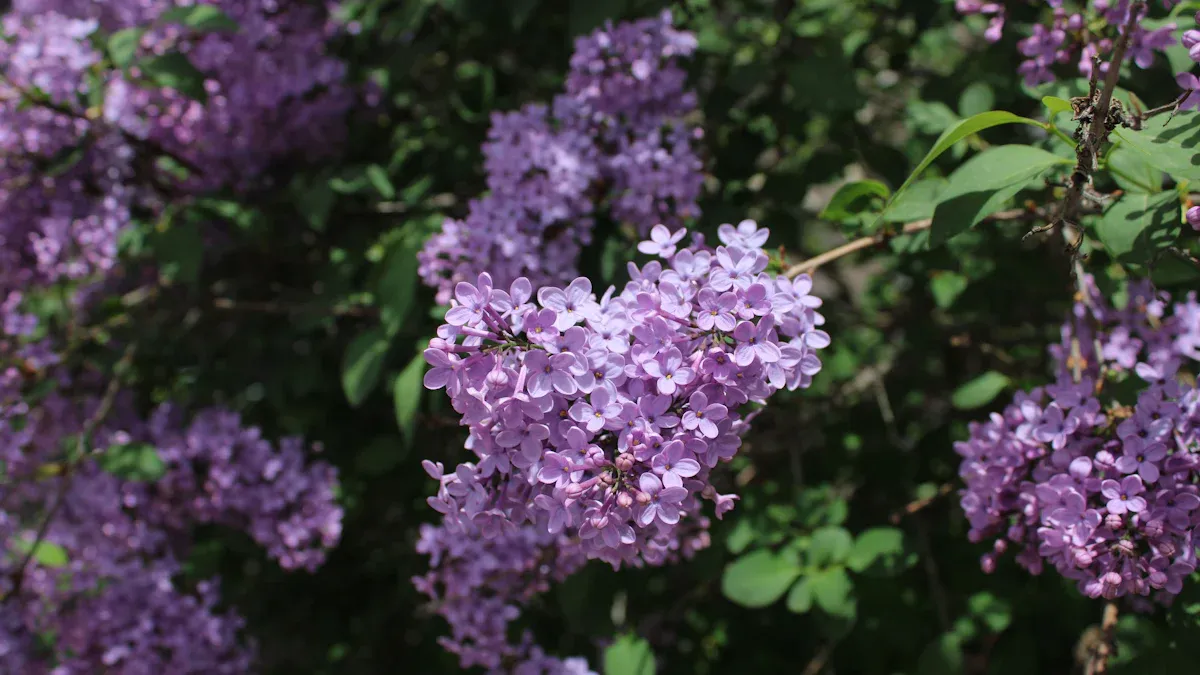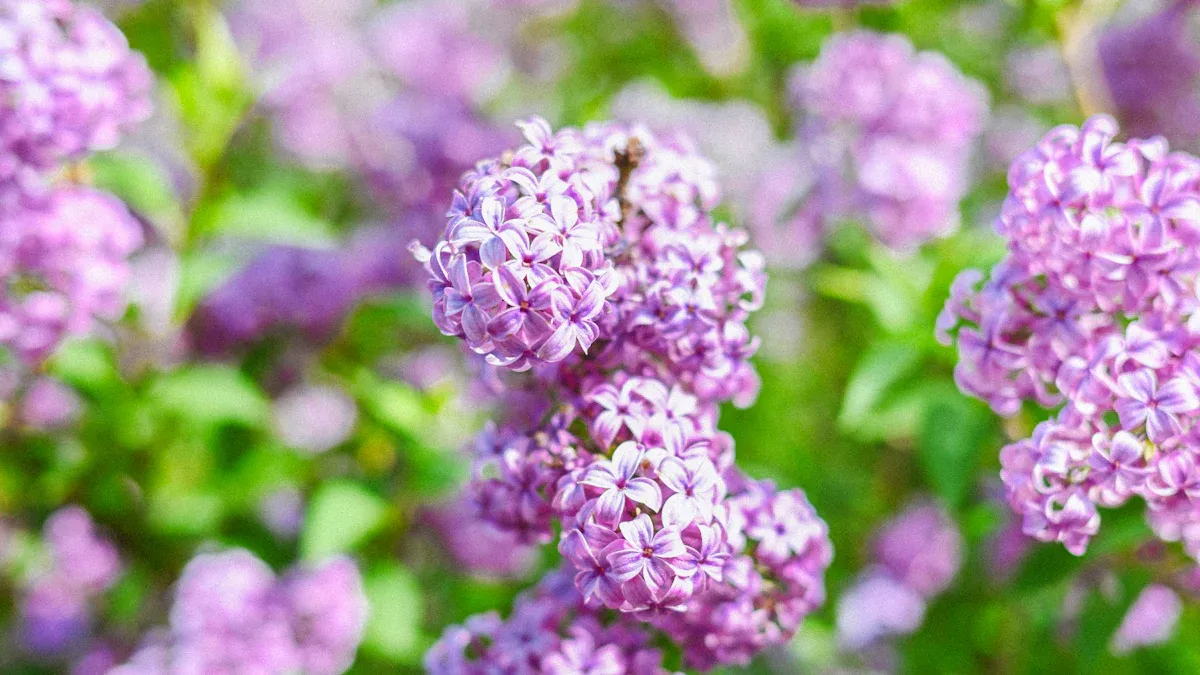
Lilacs bring vibrant color and delightful fragrance to your garden, making them a cherished favorite. However, to properly care for lilacs, they need extra attention during late winter and early spring. Protecting them from harsh weather, pruning correctly, and managing watering practices are essential to ensure they thrive. Keep an eye out for challenges like harsh freezes and dehydration, which can affect their health.
Key Takeaways
Prune lilacs right after they bloom in spring to encourage more flowers next year.
Water lilacs every 10 to 14 days in spring, providing about 1 inch of water weekly for healthy growth.
Fertilize with a balanced mix like 10-10-10 in early spring to boost blooming potential.
Winter Protection for Lilacs

When caring for lilacs, winter protection is crucial. You want to ensure your plants survive the harsh conditions. One effective way to do this is through mulching.
Mulching Techniques
Mulch acts as a protective blanket for your lilacs. It helps maintain consistent soil temperatures, which is vital during winter. Here are some benefits of using mulch:
It prevents extreme cold from damaging the roots.
Mulch protects against temperature fluctuations that can cause soil heaving. This is especially harmful to shallow-rooted plants like lilacs, as it can push their roots out of the ground.
A good layer of mulch keeps the soil frozen during warm spells, reducing the risk of your lilacs breaking dormancy too early.
For optimal protection, apply 2 to 4 inches of organic material, such as straw, bark chips, or wood chips. Here are some recommended materials:
Sawdust: Spread a layer 3 to 4 inches deep. Reapply fresh sawdust every year, but remember it may require nitrogen-rich fertilizer due to nitrogen depletion.
Wood Chips: Spread 2 to 3 inches deep, leaving 1 to 2 inches from the trunk. They improve soil drainage and add organic matter.
Hay: Apply 3 to 4 inches around newly planted lilacs in the fall to retain moisture and prevent frost heaving.
Covering Plants
In addition to mulching, consider covering your lilacs during extreme cold spells. Use burlap or frost cloth to shield them from harsh winds and freezing temperatures. This extra layer can help keep your plants safe until spring arrives.
By taking these steps, you can ensure your lilacs remain healthy and vibrant as they transition into the growing season.
Pruning Lilacs for Healthy Growth

Pruning lilacs is essential for their health and blooming potential. You want to make sure you do it at the right time and with the right techniques. This way, your lilacs will flourish and produce beautiful flowers.
Timing and Techniques
The best time to prune lilacs is right after they finish blooming in the spring. This timing is crucial because:
Pruning too late can cut off next year’s blooms. Lilacs form their flower buds immediately after the current year’s flowers fade.
If you prune right after flowering, you avoid removing the buds for next year’s blooms.
Here are some effective techniques for pruning lilacs:
Rejuvenation Pruning: This method involves cutting back older lilac bushes to encourage new growth. It’s best done during late winter or early spring, just before new growth begins. This technique helps stimulate healthy shoots and enhances flowering.
Avoid Drastic Cuts: When pruning, remove old wood but avoid excessive pruning. You should not remove more than 20% of live wood at once. This helps maintain the plant’s health and encourages blooming.
Work With Clean Tools: Always use clean tools to prevent transferring diseases. This simple step can make a big difference in your lilac’s health.
Remember, improper pruning can lead to the removal of flower buds. This mistake results in fewer blooms for the next season. Techniques like shearing can create thick, woody stems that are more vulnerable to pests, further compromising your plant’s health.
Tools Needed for Pruning
Using the right tools makes pruning easier and more effective. Here’s a list of tools you should consider:
Tool | Description | Effective For |
|---|---|---|
Bypass pruner | Small hand shears with a thin blade that slides past a thick blade. | Twigs and stems up to 0.5 inches |
Lopping shears | Long-handled shears for scissoring motion. | Branch widths between 0.5 and 2 inches |
Pole pruner | A hooked blade on a long pole for high branches. | High branches |
Hedge shears | Large scissors for shaping small leaf lilacs. | Shaping hedges and round forms |
Pruning saw | A folding saw for cutting large trunks or branches. | Large trunks or branches |
By using these tools, you can ensure a clean cut, which promotes better healing and growth for your lilacs.
Care for Lilacs: Watering Practices
Understanding soil moisture is key to keeping your lilacs healthy. Lilacs thrive in well-draining soil, which helps prevent root damage from frozen water. During late winter and early spring, you should pay attention to the moisture levels in the soil. Here are some important points to consider:
Lilacs need occasional watering during winter to avoid dehydration, especially if the ground is frozen.
A good watering of about 2 to 3 gallons before the ground freezes ensures your lilacs are well-hydrated.
Fluctuations in soil moisture can lead to root rot, negatively affecting root development. Proper management is essential for healthy lilacs.
Frequency and Amount of Watering
As spring approaches, you’ll want to adjust your watering routine. Here’s what you need to know:
Water your lilacs once every 10 to 14 days from spring until blooming ends. This frequency helps maintain consistent moisture without overwatering.
Aim for about 1 inch of water per week for mature lilac bushes during the transition from winter to spring. Deep watering once a week is ideal.
Remember, lilacs prefer slightly dry conditions once established. Allow the soil to dry out between watering sessions to promote healthy root development.
Here’s a quick checklist for watering your lilacs:
Ensure the planting area has good drainage. Lilacs do not tolerate wet conditions.
Water deeply and infrequently to encourage strong root growth.
Monitor the soil moisture regularly. If the top inch of soil feels dry, it’s time to water.
By following these watering practices, you’ll help your lilacs flourish as they prepare for their beautiful blooms.
Fertilizing Lilacs
Fertilizing your lilacs is an important step in ensuring they bloom beautifully. Timing is everything when it comes to feeding these lovely plants.
Timing for Fertilization
You should fertilize your lilacs in early spring, just as they start to wake up from their winter slumber. This timing allows the nutrients to be absorbed before the plant begins to leaf out. If you wait too long, the plant will use those nutrients for foliage growth instead of blooming. Here are some key points to remember:
Fertilize after the second year of planting.
Apply a balanced fertilizer, like a 10-10-10 general-purpose mix, when active growth begins.
Light fertilization in early spring helps your lilacs focus on blooming rather than just growing leaves.
Types of Fertilizer
When it comes to choosing the right fertilizer, you have several options. Here’s a quick comparison of some effective fertilizers for lilacs:
Fertilizer Name | NPK Ratio | Pros | Cons |
|---|---|---|---|
Espoma Organic Bone Meal | 4-12-0 | Natural source of phosphorus and nitrogen. | Not suitable for potassium-hungry plants. |
Miracle-Gro Bloom Booster Fertilizer | 15-30-15 | Immediate results and easy application. | Requires more than one box for large areas. |
Jacks Classic No.1.5 Fertilizer | 20-20-20 | Supports bud development and green foliage. | May be too strong for nutrient-rich soil. |
Jobe’s Fertilizer Spikes | 9-8-7 | Lasts up to 8 weeks and is convenient. | Can separate in dry soil. |
Scotts Flowering Tree & Shrub Food | 11-7-7 | Best for well-composted soil. | Not recommended for potted plants. |
Using granular fertilizer in early spring can significantly boost your lilacs’ blooming potential. Remember, over-fertilizing can lead to excessive foliage growth at the expense of blooms. So, stick to light applications to keep your lilacs healthy and vibrant!
Caring for lilacs during late winter and early spring is vital for their health and blooming potential. Remember these key points:
Prune immediately after flowering to promote future blooms.
Water adequately, especially during dry spells.
Fertilize with a balanced mix in early spring for vibrant flowers.
By following these tips, you’ll enjoy a thriving lilac garden! 🌸
FAQ
How often should I water my lilacs in early spring?
Water your lilacs every 10 to 14 days, providing about 1 inch of water weekly for healthy growth.
When is the best time to prune lilacs?
Prune lilacs right after they bloom in spring to avoid cutting off next year’s flower buds.
What type of fertilizer is best for lilacs?
Use a balanced fertilizer like 10-10-10 in early spring to promote vibrant blooms and healthy growth. 🌸

